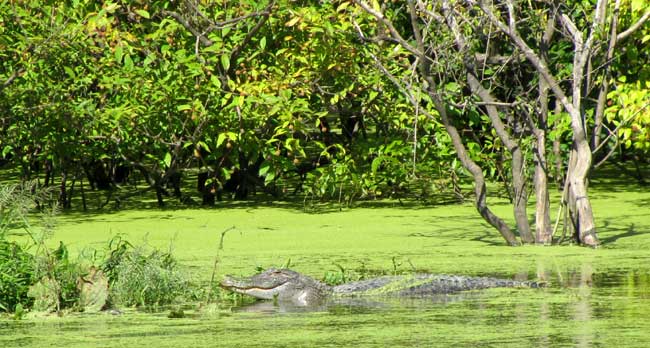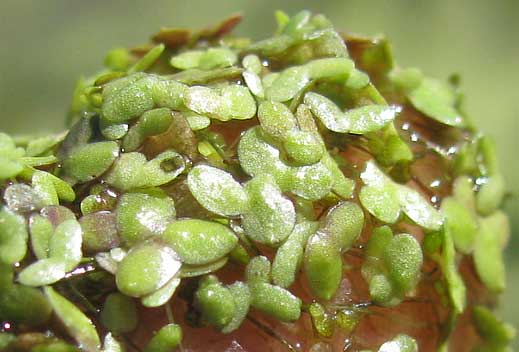Excerpts from Jim Conrad's
Naturalist Newsletter

from the October 25, 2009 Newsletter, from near Natchez, Mississippi
LOTS OF DUCKWEED
Nowadays much of the Refuge's standing water is carpeted with green duckweed, as you can see in the picture of the smiling Alligator surrounded by Buttonbushes and his back sprinkled with duckweed above.
Duckweeds -- genus Lemna in the Duckweed Family, the Lemnaceae -- consist of tiny, flat, usually oval fronds typically floating free on the water's surface, dangling below one or more pale roots which do not root in the mud. Flowers are seldom seen; reproduction is mostly by budding. Some fronds cover my fingertip below:

The Flora of North America lists nine duckweed species for our continent. They can be hard to distinguish so I'm only somewhat sure that what's on my finger is LEMNA MINUTA. I'm calling it that because the fronds bear only a single obscure vein.
It feels good to see all that duckweed, to think about it photosynthesizing so much oxygen for us all, and providing so much good food for wildlife, especially waterfowl.
Nowadays duckweeds are being grown in ponds of potentially dangerous sewage and wastewater. The duckweeds thrive on nutrients released in the water but do not normally take toxins into their own bodies, so they can be skimmed off and fed to livestock, thus recycling nutrients that otherwise would be lost.
from the December 14, 2003 Newsletter, from near Natchez, Mississippi
DUCKWEED FRUITS
Duckweed flowers are about as stripped down as possible. A single duckweed plant body, referred to as a frond, bears three flowers, two of which are male, the other being female. The flowers bear no calyx or corolla. Male flowers consist of a single pollen- producing stamen, and female blossoms are composed of nothing but a single naked pistil. In the picture linked to above you see the two stamens overtopping the single pistil.
I've always wanted to see those flowers in real life so this week I took my handlens, got on my belly at the edge of our Woodland Pond, and scanned hundreds of fronds. I found no flowers, but I did discover some fruits, which was nearly as exciting. With the naked eye the fruits looked like smallish, individual grains of dun-colored sand atop fading, dying duckweed bodies. Only with strong magnification could any detail be seen.
The fruiting plants were not floating on the water's surface. Among the many thousands of plants seen, only a half dozen or so were found with fruits, and all of these had been left stranded three to six inches high on an emergent stump as the water sank after the last rain. Probably the stress of being marooned out of water stimulated the fronds to flower and fruit. All the fruiting fronds were dead or dying. Green, healthy-looking duckweeds floating on the water's surface were busily reproducing by budding. At the first link mentioned above you can see how duckweeds nearly always appear as two or more fronds stuck together, not alone. The smaller fronds in such clusters have budded off the largest one.
Whenever you see a body of water covered with "green confetti," it's worth paying attention to who that confetti is. Often two or more species are present. In our area the most common duckweed is LEMNA PERPUSILLA, but other species of the genus Lemna also might be found. Besides duckweed, there is also "Great Duckweed" of the genus Spirodela. Duckweed fronds have a single "root" dangling into the water, while those of Great Duckweed have two or more. Great Duckweed fronds are generally larger than those of regular duckweed. Also in the Duckweed Family and even smaller than Lemna species are members of the two genera Wolffiella and Wolfia, which look like tiny, short, green threads and globular spheres, respectively. These last two genera are famous for supplying the smallest of all fruits known in nature, being 1/100th of an inch long (0.25 mm) and weighing only about 1/400,000 of an ounce (70 micrograms).